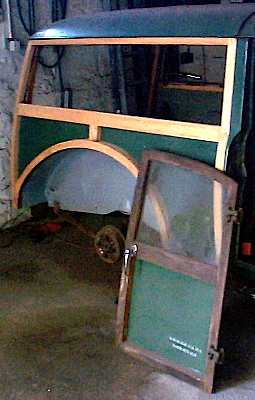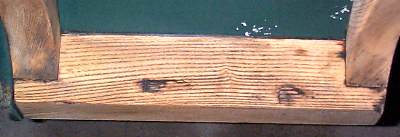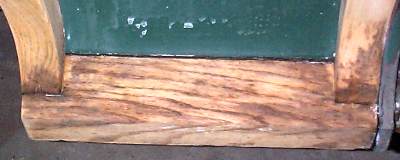Traveller varnish removal
Forum rules
By using this site, you agree to our rules. Please see: Terms of Use
By using this site, you agree to our rules. Please see: Terms of Use
-
alex_holden
- Minor Legend
- Posts: 3798
- Joined: Tue Jul 25, 2006 9:46 am
- Location: Burnley
- MMOC Member: No
Traveller varnish removal
Any suggestions on the best way to remove old varnish from a Traveller's external woodwork?
I suspect Fenchurch might never been revarnished from new. When I got her, large areas of the varnish had already flaked off, and I got much of the remainder off with an electric sander. Chemical varnish stripper has removed some more, but despite about twelve hours trying, there are still some patches remaining that the stripper seems unable to get rid of completely.
Plan C is to attempt to shave it off with a razor-sharp scraper - I've saved that technique for last because I'm worried about damaging the wood. I did try doing a small area with a very sharp chisel, but after about 10 minutes of scraping I didn't seem to have reached the surface of the wood yet (annoyingly I find it difficult to tell when the last of the varnish has gone from an area).
I suspect Fenchurch might never been revarnished from new. When I got her, large areas of the varnish had already flaked off, and I got much of the remainder off with an electric sander. Chemical varnish stripper has removed some more, but despite about twelve hours trying, there are still some patches remaining that the stripper seems unable to get rid of completely.
Plan C is to attempt to shave it off with a razor-sharp scraper - I've saved that technique for last because I'm worried about damaging the wood. I did try doing a small area with a very sharp chisel, but after about 10 minutes of scraping I didn't seem to have reached the surface of the wood yet (annoyingly I find it difficult to tell when the last of the varnish has gone from an area).


Alex Holden - http://www.alexholden.net/
If it doesn't work, you're not hitting it with a big enough hammer.
-
Mike Shipman
- Minor Fan
- Posts: 475
- Joined: Wed Feb 13, 2002 12:00 am
- Location: New Forest, Hampshire.
- MMOC Member: Yes
Hi Alex, Ive stripped back the wood on a couple of travs, Ive used a cabinet scraper rather than a "razor sharp scaper", I think you have more control and less likelihood of accidentaly cutting into the grain. Ive found the finish you get from cabinet scraping is excellent.
If youre not familiar with the cabinet scraper, this article could help:
http://www.finefurnituremaker.com/news/ ... p?m=200504
Regards, Mike.
If youre not familiar with the cabinet scraper, this article could help:
http://www.finefurnituremaker.com/news/ ... p?m=200504
Regards, Mike.
Mike Shipman,
Seaton, Torpoint, Cornwall.
Seaton, Torpoint, Cornwall.
-
Mike Shipman
- Minor Fan
- Posts: 475
- Joined: Wed Feb 13, 2002 12:00 am
- Location: New Forest, Hampshire.
- MMOC Member: Yes
-
alex_holden
- Minor Legend
- Posts: 3798
- Joined: Tue Jul 25, 2006 9:46 am
- Location: Burnley
- MMOC Member: No
The scraper I have has a similar blade in a different style of handle. I'll give that a try today and if it doesn't work I'll have to track down a proper cabinet scraper.
This might sound like a stupid question, but is there a foolproof way to tell for sure that you've got all the varnish off? The hardwood underneath the varnish is very smooth and unstained, and it looks much the same to me as the varnished wood. The difference became more obvious once I tried bleaching it, because the areas where I'd got the varnish off went lighter.
This might sound like a stupid question, but is there a foolproof way to tell for sure that you've got all the varnish off? The hardwood underneath the varnish is very smooth and unstained, and it looks much the same to me as the varnished wood. The difference became more obvious once I tried bleaching it, because the areas where I'd got the varnish off went lighter.


Alex Holden - http://www.alexholden.net/
If it doesn't work, you're not hitting it with a big enough hammer.
-
Willie
- Minor Legend
- Posts: 3204
- Joined: Tue Feb 12, 2002 12:00 am
- Location: S E London
- MMOC Member: No
varnish removal
In the March issue of 'Minor Monthly' there is a useful article on the treatment of Traveller woodwork. ( he uses a chisel for varnish removal
but he is a professional)!
but he is a professional)!
Willie
[img]http://i39.photobucket.com/albums/e197/wuzerk/mo9.jpg[/img]
[img]http://i39.photobucket.com/albums/e197/wuzerk/mo9.jpg[/img]
-
alex_holden
- Minor Legend
- Posts: 3798
- Joined: Tue Jul 25, 2006 9:46 am
- Location: Burnley
- MMOC Member: No
I've just honed up a good quality chisel and then burnished the edge with a piece of tool steel similar to what is described in the cabinet scraper article above, and it's shaving the recalcitrant patches of varnish off with almost no effort at all! 


Alex Holden - http://www.alexholden.net/
If it doesn't work, you're not hitting it with a big enough hammer.
-
alex_holden
- Minor Legend
- Posts: 3798
- Joined: Tue Jul 25, 2006 9:46 am
- Location: Burnley
- MMOC Member: No
I don't think they had PU varnish 44 years ago did they? Some kind of resin perhaps? Whatever it was it certainly wasn't too bothered by the chemical stripper.
I've managed to get it all off (I hope) by shaving it with a razor sharp chisel. The surface went a bit "furry" in places but a quick rub-down with fine sandpaper fixed that.
Back to the bleaching... It's already looking way better than it did when I bought her.
I've managed to get it all off (I hope) by shaving it with a razor sharp chisel. The surface went a bit "furry" in places but a quick rub-down with fine sandpaper fixed that.
Back to the bleaching... It's already looking way better than it did when I bought her.


Alex Holden - http://www.alexholden.net/
If it doesn't work, you're not hitting it with a big enough hammer.
-
iandromiskin
- Minor Fan
- Posts: 475
- Joined: Fri Jun 30, 2006 8:51 am
- Location: Dromiskin, Co. Louth, Ireland
- MMOC Member: No
Hi, I'am in the middle of doing the same to my traveller too, but using a sharp blade or broken glass. I find both work very well, but it took practice not to cut into the grain.
But next question, how do I prepare the wood next - basically a good hard sanding down ??? Also, parts of the wood are black and need bleaching or whatever, so how do I go about this proberly ? Do I just bleach those parts that need it or the whole timber to get it all looking the same ?? I understand also that it will need about 5 - 7 initial coats of Dutch oil too afterwards - yes ???
Ian.
But next question, how do I prepare the wood next - basically a good hard sanding down ??? Also, parts of the wood are black and need bleaching or whatever, so how do I go about this proberly ? Do I just bleach those parts that need it or the whole timber to get it all looking the same ?? I understand also that it will need about 5 - 7 initial coats of Dutch oil too afterwards - yes ???
Ian.
-
alex_holden
- Minor Legend
- Posts: 3798
- Joined: Tue Jul 25, 2006 9:46 am
- Location: Burnley
- MMOC Member: No
I did give the wood a light sanding after scraping the varnish off, but only because the scraper had dug in and made the surface a bit "furry" in places.
I've been bleaching it with Oxalic acid. It's slow but pretty effective. I'm no expert, but the way I've been doing it is to mix up a batch, paint it onto all the wood twice (the first coat soaks straight in and leaves the surface fairly dry), and then occasionally paint another coat on to prevent it drying out. After about an hour, wash it with water, dry it with a hot air gun, then start all over again. I tried just painting coat after coat of bleach on without the washing/drying step, but it seems to stop working after a while if you never wash the old stuff off. I've bleached it five times so far, and the appearance is greatly improved but there are still a few stubborn stains that haven't gone completely.
I took this photo this morning showing what a difference the bleaching has made compared to the untreated back door:

It doesn't quite look that good close-up. The worst bits are the foot rails:


I'm planning to paint it with Cuprinol clear wood preserver after I've finished the bleaching, then use Danish oil for the final finish (based on advice from a friend who's a professional furniture restorer).
I've been bleaching it with Oxalic acid. It's slow but pretty effective. I'm no expert, but the way I've been doing it is to mix up a batch, paint it onto all the wood twice (the first coat soaks straight in and leaves the surface fairly dry), and then occasionally paint another coat on to prevent it drying out. After about an hour, wash it with water, dry it with a hot air gun, then start all over again. I tried just painting coat after coat of bleach on without the washing/drying step, but it seems to stop working after a while if you never wash the old stuff off. I've bleached it five times so far, and the appearance is greatly improved but there are still a few stubborn stains that haven't gone completely.
I took this photo this morning showing what a difference the bleaching has made compared to the untreated back door:

It doesn't quite look that good close-up. The worst bits are the foot rails:


I'm planning to paint it with Cuprinol clear wood preserver after I've finished the bleaching, then use Danish oil for the final finish (based on advice from a friend who's a professional furniture restorer).


Alex Holden - http://www.alexholden.net/
If it doesn't work, you're not hitting it with a big enough hammer.
-
iandromiskin
- Minor Fan
- Posts: 475
- Joined: Fri Jun 30, 2006 8:51 am
- Location: Dromiskin, Co. Louth, Ireland
- MMOC Member: No
Wow ! Thats some difference !!!! 
 My wood is quite good on one side with only some staining. The other side for some reason is a bit darker in appearance, even after I remove the varnish. But I think I will give it a light sanding too as I have a bit of fuzz also.
My wood is quite good on one side with only some staining. The other side for some reason is a bit darker in appearance, even after I remove the varnish. But I think I will give it a light sanding too as I have a bit of fuzz also.
So re the bleaching - you do paint it on all of the wood about five times. My wood at the moment actually looks like your after treatment, its only in places where it is stained. But I'll give it a go.
I presume the cuprinol is also painted onto the wood and absorbed. How many coats do you apply do you know ? Then you paint on the Dutch oil as normal (after drying of course) ?
I did a video of my car yesterday while I working on it, which I hope to upload to youtube tomorrow.
So re the bleaching - you do paint it on all of the wood about five times. My wood at the moment actually looks like your after treatment, its only in places where it is stained. But I'll give it a go.
I presume the cuprinol is also painted onto the wood and absorbed. How many coats do you apply do you know ? Then you paint on the Dutch oil as normal (after drying of course) ?
I did a video of my car yesterday while I working on it, which I hope to upload to youtube tomorrow.
-
Kevin
- Moderator

- Posts: 7592
- Joined: Thu Feb 14, 2002 12:00 am
- Location: Watford, Hertfordshire.
- MMOC Member: No
Clear cuprinol is what was used in the factory and I believe it was dipped to allow it to soak in and I would expect if your wood is really dry it will take quite a few coats to soak right in and I would have thought at least 3 you should be able to judge by how quick it absorbs it.I presume the cuprinol is also painted onto the wood and absorbed. How many coats do you apply do you know ?
Also I know its horses for courses but I dont like the oil finishes because if you use the car much it seems to pick up an ingrained dirt finish with useage, I am not critising a professional furniture restorer but a car does not have the same usage as a piece of furniture or have to put up with such differing weather conditions, I personally prefer the advice given by Steve Foreman as he makes and restores the wood for Travellers, but each to his own.
Also borrowed from the other woodwork posting
Danish oil, Deks Olje, Owenircl etc. Experience of this type of finish has shown it to be ineffective on ash, unless regular coats are applied, i 3-4 times per year. Application is a long and laborious task, requiring upwards of 10 coats. It does not solve the problem of water ingress at the joints.
Cheers
Kevin
Lovejoy 1968 Smoke Grey Traveller (gone to a new home after13 years)
Herts Branch Member
Moderator MMOC 44706
Kevin
Lovejoy 1968 Smoke Grey Traveller (gone to a new home after13 years)
Herts Branch Member
Moderator MMOC 44706
-
chickenjohn
- Minor Legend
- Posts: 4064
- Joined: Tue Dec 07, 2004 8:50 am
- Location: Margate, East Kent
- MMOC Member: No
I found that using a "skarsten scraper" was quite effective  (a scraper with sharp blade at right angle to the handle) at removing old varnish. What I did was to paint on a couple of coats of oxalic acid wood bleach solution, let it soak in for a while, and whilst still damp, draw the scraper across the wood going with the grain to minimise damage. It seemed to remove the old varnish and much of the darkening. The varnish came off quite easily this way for me. Then sand (when dry) with medium and fine glasspaper to get the wood smooth before cuprinol and then (in my case) Sikkens light oak exterior semi gloss woodstain.
(a scraper with sharp blade at right angle to the handle) at removing old varnish. What I did was to paint on a couple of coats of oxalic acid wood bleach solution, let it soak in for a while, and whilst still damp, draw the scraper across the wood going with the grain to minimise damage. It seemed to remove the old varnish and much of the darkening. The varnish came off quite easily this way for me. Then sand (when dry) with medium and fine glasspaper to get the wood smooth before cuprinol and then (in my case) Sikkens light oak exterior semi gloss woodstain.
It needs doing again now though- on the old side of wood.
 (a scraper with sharp blade at right angle to the handle) at removing old varnish. What I did was to paint on a couple of coats of oxalic acid wood bleach solution, let it soak in for a while, and whilst still damp, draw the scraper across the wood going with the grain to minimise damage. It seemed to remove the old varnish and much of the darkening. The varnish came off quite easily this way for me. Then sand (when dry) with medium and fine glasspaper to get the wood smooth before cuprinol and then (in my case) Sikkens light oak exterior semi gloss woodstain.
(a scraper with sharp blade at right angle to the handle) at removing old varnish. What I did was to paint on a couple of coats of oxalic acid wood bleach solution, let it soak in for a while, and whilst still damp, draw the scraper across the wood going with the grain to minimise damage. It seemed to remove the old varnish and much of the darkening. The varnish came off quite easily this way for me. Then sand (when dry) with medium and fine glasspaper to get the wood smooth before cuprinol and then (in my case) Sikkens light oak exterior semi gloss woodstain.It needs doing again now though- on the old side of wood.
Cheers John - all comments IMHO
- Come to this years Kent branches Hop rally! http://www.kenthop.co.uk
(check out the East Kent branch website http://www.ekmm.co.uk )


- Come to this years Kent branches Hop rally! http://www.kenthop.co.uk
(check out the East Kent branch website http://www.ekmm.co.uk )
